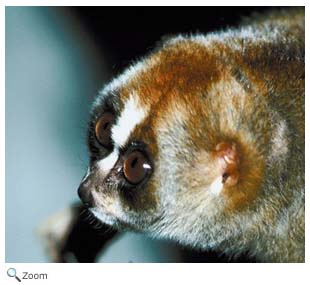Lorisidae - lorises,
pottos, angwantibos
 There are 10 species of small primates in this family. Lorises are found in Asia. Pottos and angwantibos are found in Africa. Lorises, pottos and angwantibos have thick, wooly fur; short or no tails; and big, round eyes. There are 10 species of small primates in this family. Lorises are found in Asia. Pottos and angwantibos are found in Africa. Lorises, pottos and angwantibos have thick, wooly fur; short or no tails; and big, round eyes.
The primates in this family live in trees, but unlike other primates, they do not swing or leap from branch to branch. They slowly crawl around on tree branches.
They can crawl on the top of a branch, or hang upside down and crawl on the underside of a branch. Lorises, pottos, and angwantibos are nocturnal. They spend the day resting in tree hollows or on tree branches. At night the slowly crawl around the tree branches searching for fruit and insects.
World Status Key
 Least Concern Least Concern  Near Threatened Near Threatened  Vulnerable Vulnerable  Endangered Endangered  Critically Endangered Critically Endangered  Extinct in Wild Extinct in Wild  Extinct Extinct
Status and range is taken from ICUN Redlist. If no status is listed, there is not enough data to establish status.
US Status Key
 Threatened in US Threatened in US  Threatened in NH Threatened in NH  Endangered in US Endangered in US  Endangered in NH Endangered in NH  Introduced Introduced
Status taken from US Fish and Wildlife and NH Fish and Game
New Hampshire Species |
|
North/Central American Species |
| None |
|
None |
Additional Information
Key:  Profile Profile  Photos Photos  Video Video  Audio Audio
Bengal Slow Loris - Nycticebus bengalensis    
The Bengal slow loris is found in Bangladesh, Cambodia, China, India, Laos, Myanmar, Thailand, and Vietnam.
Source: Arkive Intended Audience: General Reading Level: Middle School
Bornean Slow Loris - Nycticebus menagensis    
The Bornean slow loris is found in Brunei Darussalam, Indonesia, Malaysia, and the Philippines.
Source: Arkive Intended Audience: General Reading Level: Middle School
Calabar Angwantibo - Arctocebus calabarensis    
The Calabar angwantibo is found in Cameroon and Nigeria.
Source: Animal Diversity Web Intended Audience: General Reading Level: Middle School
Gray Slender Loris - Loris lydekkerianus     
The gray-slender loris is found in India and Sri Lanka.
Source: Arkive Intended Audience: General Reading Level: Middle School
Greater Slow Loris - Nycticebus coucang    
The greater slow loris is found in Indonesia, Malaysia, Singapore, and Thailand.
Source: Arkive Intended Audience: General Reading Level: Middle School
Greater Slow Loris - Nycticebus coucang    
Greater slow lorises are covered with short, thick, woolly fur in a variety of colors and patterns.
Source: Animal Diversity Web Intended Audience: General Reading Level: Middle School
Greater Slow Loris - Nycticebus coucang    
The greater slow loris stays motionless for hours.
Source: Los Angeles Zoo Intended Audience: General Reading Level: Middle School
Greater Slow Loris - Nycticebus coucang    
The greater slow loris eats eat snails, insects, lizards, birds, small mammals, and fruit.
Source: Woodlands Park Zoo Intended Audience: General Reading Level: Middle School
Javan Slow Loris - Nycticebus javanicus   
The Javan slow loris is found in Indonesia.
Source: Arkive Intended Audience: General Reading Level: Middle School
Potto - Perodicticus potto     
The potto is found in Angola, Benin, Burundi, Cameroon, Central African Republic, Congo, Côte d'Ivoire, Equatorial Guinea, Gabon, Ghana, Guinea, Kenya, Liberia, Nigeria, Rwanda, Sierra Leone, Togo, and Uganda.
Source: Arkive Intended Audience: General Reading Level: Middle School
Potto - Perodicticus potto    
Pottos have long, slender bodies, large eyes, and small, round ears.
Source: Animal Diversity Web Intended Audience: General Reading Level: Middle School
Potto - Perodicticus potto     
Pottos leave urine trails along branches to communicate with each other through scent.
Source: Cincinnati Zoo Intended Audience: General Reading Level: Middle School
Pygmy Slow Loris - Nycticebus pygmaeus    
The pygmy slow loris is found in Cambodia, Laos, and Vietnam.
Source: Animal Diversity Web Intended Audience: General Reading Level: Middle School
Slender Loris - Loris tardigradus   
The slender loris is found in Sri Lanka.
Source: Arkive Intended Audience: General Reading Level: Middle School
Slender Loris - Loris tardigradus    
The slender loris is nocturnal and lives in trees.
Source: Animal Diversity Web Intended Audience: General Reading Level: Middle School |

